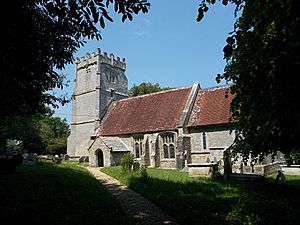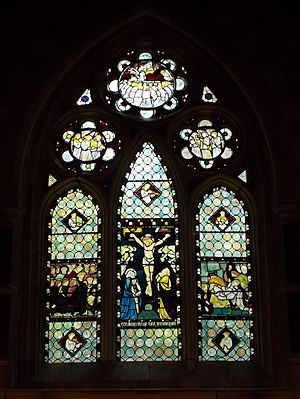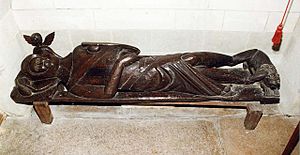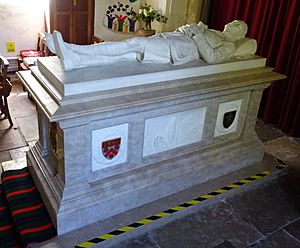St Olave's Church, Gatcombe facts for kids
Quick facts for kids St Olave's Church, Gatcombe |
|
|---|---|
 |
|
| 50°39′49″N 01°18′15″W / 50.66361°N 1.30417°W | |
| Denomination | Church of England |
| Churchmanship | Broad Church |
| Website | www.stolaves.church |
| History | |
| Dedication | St Olave's |
| Administration | |
| Parish | Gatcombe |
| Diocese | Portsmouth |
| Province | Canterbury |
St Olave's Church, Gatcombe is a historic parish church in the Church of England. It is found in the village of Gatcombe on the Isle of Wight. This church is part of a group of churches that includes Sts Thomas Minster, Newport, St John's, Newport, and St Mary's, Carisbrooke.
Contents
History of St Olave's Church
Building the church started way back in the 13th century. It was officially opened in the year 1292. The church first served as a private chapel for the Estur family, who lived at Gatcombe House. Later, the Worsley family owned the manor. They gave money to the church and some family members even became its rectors.
The church's font, which is a basin used for baptisms, is likely from the early 1200s. The chancel, which is the area around the altar, was rebuilt in 1864–65. The church was also repaired and improved around 1920. The tower has three bells, but they are not rung in the usual way.
Beautiful Stained Glass Windows
St Olave's Church is famous for its amazing stained glass windows. These windows were made in 1865 and 1866. They were designed by very well-known artists. These artists include William Morris, Dante Gabriel Rossetti, Ford Madox Brown, and Edward Burne-Jones.
These artists were all connected to a group called the Pre-Raphaelite Brotherhood. Rossetti helped start this group. Their beautiful work makes the church's windows very special.
Important Monuments and Statues
Inside the church, there are some interesting monuments. One is a carved wooden statue of a soldier. It shows him with crossed legs, a style popular in the early 1300s. This statue lies in a special spot near the altar. It has an angel by its head and a lion at its feet.
People are not sure if this statue is truly from the medieval period. Some think it might be an older piece that was changed later. Others believe it was made more recently to look old. There are many stories about this statue. In the 1960s, it even inspired a famous prank called the "Lucy Lightfoot" hoax.
Memorial to Captain Charles Grant Seely
At the back of the church, there is a large memorial for Captain Charles Grant Seely. He was the oldest son of Sir Charles Seely, 2nd Baronet. Captain Seely was a soldier who died in battle in 1917 during the Second Battle of Gaza. He is buried in a war cemetery in Gaza.
The memorial looks like a stone tomb with a statue of Captain Seely lying on top. He is shown in his army uniform with his legs crossed. This was a way to show he was like a modern-day "crusader." This statue was the last work of a famous sculptor named Sir Thomas Brock. It was revealed in 1922.
In 1927, the memorial was damaged by a local woman. She seemed upset that her own brother, who also died in the war, did not have such a grand memorial. You can still see the damage on the statue's face and sword today.
The Church Organ
The organ in St Olave's Church was built in 1919 by Henry Speechly. Sir Charles and Lady Seely gave the organ to the church. It was a memorial to all the soldiers from the Isle of Wight Rifles who died in the First World War. The organ was officially dedicated in September 1922. This happened at the same time the memorial to Charles Grant Seely was revealed.
The special room where the organ is kept was designed by W. D. Caröe. In 2000, the organ was repaired and updated. Some parts from an organ in Upper Chine School were added to it. You can find more details about this organ on the National Pipe Organ Register.
Churchyard and War Graves
The churchyard is the burial ground around the church. It contains two special graves called Commonwealth war graves. These graves belong to two members of the Royal Air Force Volunteer Reserve who died during World War II. One was an officer, Flight Lieutenant Antony Basil Langton, and the other was a sergeant, Sergeant William Reuben Cooper.
Gallery
See also









